Lviv isthe most European-looking city in the country, located in the west of Ukraine . The UNESCO-listed historic city center seems to have been frozen in the 19th century. When you wander the streets of the city, which is the legacy of its centuries-old history, you realize that it is a complete European in terms of both life culture and architecture. No plain, gray buildings from Soviet times.
Countless ethnicities, religions and people from all walks of life have brought this wonderful city to life. Since its establishment, it has embraced people of all nationalities with the warmth of a mother. The city's cobbled streets and interesting places, each of which attracts people, are lively. The 750-year-old city has many must-sees. There are 60 museums, 104 cathedrals and churches in the city. Every corner is full of surprises.
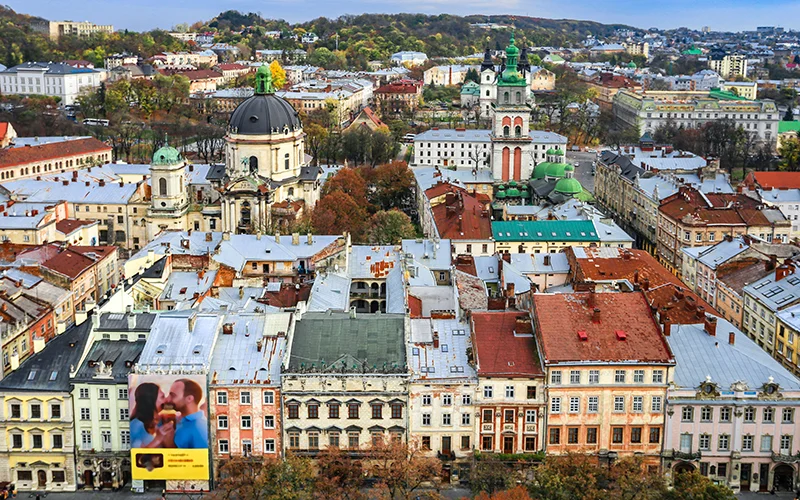
Lviv is a European city in the west of Ukraine, reflecting the modern face of its country. Lviv, which has been one of the important cultural centers of Eastern Galicia throughout history, impresses with its historical and natural beauties, and is the favorite of all Europe with its nightlife.
Located on the Polish border of Ukraine, the country with the largest surface area in Eastern Europe, Lviv is considered the cultural capital of the country. Known as Little Vienna, Little Paris, City of Museums, Ukraine's Piedmont, Ukraine's Prague, Lviv has a great place in the history of Eastern Europe.
{tocify} $title={Table of Contents}
Ukraine is on the list of visa-free countries. Moreover, it is possible to go to Lviv only with a Turkish Identity Card without issuing a passport. All you need to do is to book your Lviv flight ticket and hotel. Pegasus has very good campaigns. See the rating.
Ukraine's European City Lviv Travel Guide
Lviv Travel Guide
Lviv is located in the west of Ukraine, very close to the Polish border. Contrary to the traditional Slavic and Soviet inspired atmosphere of many Ukrainian cities, the city, which has a modern and European appearance, was one of the important cultural centers of Eastern Galicia throughout history.
Lviv was under the rule of the Polish Kingdom, the Russian and Ottoman Empires and the Kievan Rus State for a long time. Founded in the 13th century by the Galician Prince Danylo Haltsky, the prince named the city after his son Lev, which means lion in Russian. The other known names of Lviv, whose symbol is the lion, are Lwow in Polish, Lvov in Russian and Lemberg in the Austrian period.
The name of this historical city, which was the former capital of Eastern Galicia, means lion in Ukrainian. Lviv, which is often compared to Prague, is also referred to as the 'Lion City' in historical sources. Founded on old trade routes and an important settlement throughout history, Lviv has been the address of multicultural life for centuries.
The city, which has hosted the Polish, Jewish, German, Austrian and Ukrainian people throughout history, still hosts different cultures today. The population of Lviv consists of Ukrainians, Russians, Poles, Belarusians, Jews and Armenians.
In contrast to the eastern and central regions of Ukraine, where the majority speaks Russian, the mother tongue of almost all people in Lviv, on the border with Poland, is Ukrainian. Geographically located in the middle of Europe, between regions that have adopted different cultures, Lviv has a continental climate, so winters are cold and summers are hot.
Lviv, whose currency is hryvnia, is so advantageous that it can be visited on foot and does not need public transport except for a few addresses. Many cultural and artistic events and festivals are held in the city, and most of the places to visit are close to each other.
Lviv Attractions
Most of the places to visit in Lviv are located in the Old Town, which was included in the World Cultural Heritage List by UNESCO in 1998. Located at the foot of Zamovka Hill, on the banks of the Poltava River, the region has historically been at the intersection of important trade routes connecting Central Europe, the Baltic, the Mediterranean and Asia.
In addition to many architectural and artistic masterpieces, the layout of the Old Town , which includes the high castle and five churches in the surrounding area , is considered one of the best examples of the Eastern European urban planning system of the period. Fine Renaissance and baroque style houses have survived to the present day, especially in and around Rynok Square, preserving their original medieval order.
It takes both time and energy to turn the city upside down. Fortunately, almost all of the places to visit and see are within walking distance. There are extraordinary places where you can relax when you are tired, and wonderful parks that make you feel in nature, not in the city.
Mark the places to visit on Google Map and visit them one by one. Whether it's a short weekend getaway or a long 1-week vacation route, the city has the richness and variety to satisfy its guests in every aspect. Start your exploration from the heart of the city, Rynok Square.
You can watch a magnificent view of Lviv from the tower of Lviv City Hall, which is located in the middle of Rynok Square, which is the most crowded place of the city and is full every hour of the day, and can be reached by 300 steps.
Rynok Square , also known as the Market Square, is a square that has been the center of Lviv's cultural, political and commercial life for 500 years. Most of the structures here were designed and built by Italian, Austrian and German architects.
You can easily understand why Lviv is the cultural capital of Ukraine when you visit the UNESCO-listed Rynok Square and the surrounding historical region. The square, whose original state was destroyed in a great fire, was completely rebuilt in the 16th century.
The square is surrounded by colorful buildings, each with different architectural motifs and colors. The narrow cobbled streets leading to the square are home to countless delicious cafes and restaurants. Each one is interesting and beautiful enough to deserve a visit.
Exactly in the heart of the square it was built in the 14th century Town Hall (Town Hall) is rising. To witness the beauty of the square, climbing the 65-meter-high 408-step City Hall tower should be one of the first things to do in Lviv.
Most of the 44 buildings with 3 or 4 floors surrounding the square have uniform dimensions with 3 windows. Buildings with four or more windows are home to the extremely wealthy, as the maximum allowed tax-free is 3.
The cafe named Lviv Coffee Manufacture on the other corner is a historical coffee shop where you can go to relieve your tiredness when you get off the tower. Coffee culture came from the Ottoman Empire to Austria and then to Lviv. It is said that the first coffee of the city was drunk on the ground floor of this building. Maybe you can put on your helmet and drink flaming coffee in their downstairs mine-like room. There is also a wonderful garden for those who wish to go through the building.
At the four corners of Rynok Square, fountains with statues symbolizing the Greek gods Diana, Neptune, Adonis and Amphitria are erected. Black House number 4, one of the most famous buildings on its square, is now used as the Lviv Historical Museum . There was restoration work when I was in Lviv. The Pharmacy Museum, which has been open since the 1960s on the opposite street, is among the places to see in the square.
The Pharmacy Museum is a museum with many objects from old pharmacy bottles to wooden jars, antique scales and pestles. The Pharmacy Museum, which you can visit with guided tours, is the oldest known pharmacy museum of historical importance in Ukraine and Europe. The museum, which was established in 1735, was taken under protection as the History of Pharmacy Museum in 1966.
If you want to sweeten your mouth when you go out, taste the famous cherry liqueur from the shop called Drunk Cherry on the other corner, if you have the patience to queue. There is no need to rush in Lviv, services are slow, try to be patient wherever you go. If you want your energy to skyrocket, dive into the Lviv Handmade Chocolate shop just a short distance away. There are many kinds of chocolate that seduce people both visually and in terms of taste.
Lviv Chocolate Factory is the most visited address in Ukraine, famous for its chocolates. Even if you have to wait in line for a long time to visit the 5-storey factory, make sure it's worth it. In the 5-storey store, you can try many types of chocolate and buy the one you like. On the other hand, if you coincide your trip to Lviv with the Chocolate Festival held between February 9-12 every year, you can witness the skills of world-famous chocolate artists.
2. Italian Courtyard
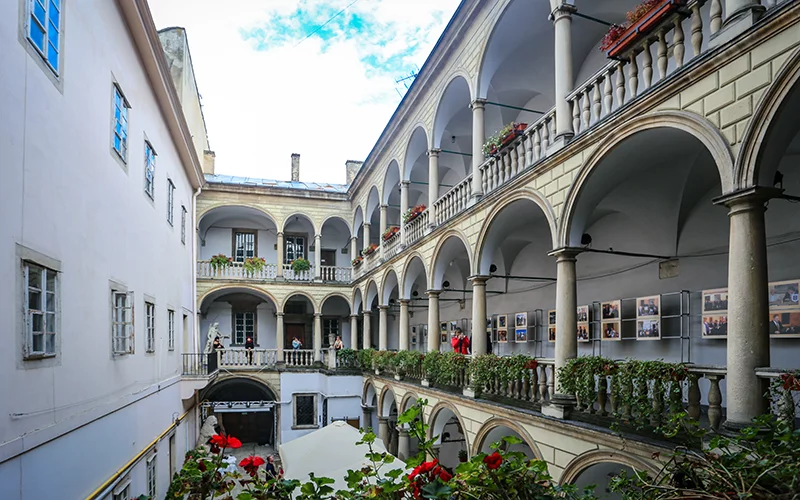
The Italian Courtyard , the inner courtyard of Korniakt Palace, which was built by the Greek merchant Konstanty Korniakt, the richest man in the city, who once traded in wine, fabric and fur trade, is striking. It looked like the courtyards I saw in Andalusia. It is accessed through the passage to the right of the Black Building in Rynok Square.
The 438-year-old palace, built by the Polish architect Piotr Barbon, was bought in 1640 by Jakub Sobieski, one of the people who lost the Ottoman Empire in the siege of Vienna. 100 years ago, Lviv city officials bought this building and opened a museum called King Jana III here. It is now part of the Lviv Historical Museum.
Rococo furniture, clocks, a collection of medallions and precious silverware from the Polish royal period are on display. Don't miss out on the arm-turned musical instrument. From time to time, jazz and classical concerts are held in the Italian courtyard. Maybe you can come across.
3. Dormition Katedrali
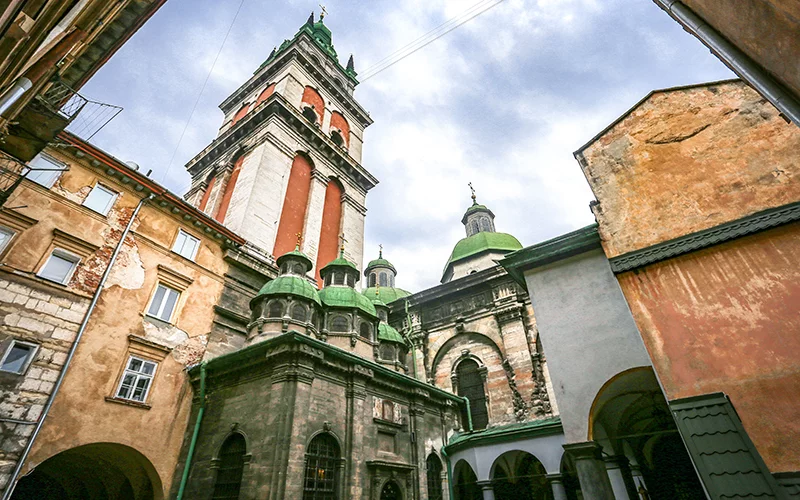
There are many churches and cathedrals that you must see in Lviv. Dormition Cathedral, located at the back of the Italian Courtyard, is one of them. One of the most outstanding landmarks of Lviv.
Funded by the trader Konstantin Kornyakt, the church was the venue for the Orthodox community. The interior of the Dormition Cathedral, also known as the Church of the Presence of the Blessed Virgin Mary (Assumption of the Blessed Virgin Mary), is decorated with paintings from the 17th and 18th centuries.
The cathedral complex is an architectural masterpiece comprising a printing house, library, school and museum. Pass through the church's old stone vault entrance gate and enter the courtyard of the church to the Chapel of the Three Saints. This is also part of the Dormition Cathedral.
4. Dominican Katedrali
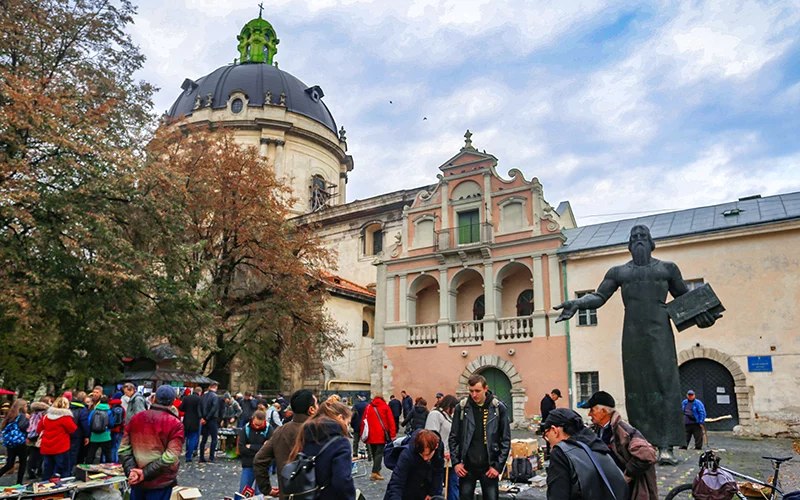
Dominican Cathedral and Monastery , one of the oldest buildings in Lviv, dating back to the 12th century. Although the cathedral, which was built with wooden materials by the members of the Dominican Order, was damaged in the fire, it was rebuilt between 1749 and 1761 and regained its present appearance.
The Latin inscription on its façade reads “Soli Deo Honor et Gloria (Glory to One God)”. The Dominican Cathedral and Monastery has been serving as the Lviv Religious History Museum since the 1970s.
A second-hand bookstore market is held every day in the square, which can be reached after leaving the Dormition Cathedral and passing by the ruins of Lviv's Medieval Walls . Various old books, records and household items are sold here. It is also a pleasant square to watch the people of Lviv. In the middle of the park is the monument to Ivan Fedorov, the first printer in Ukraine, holding a book in one hand and a grain in the other.
5. Arsenal Weapons Museum
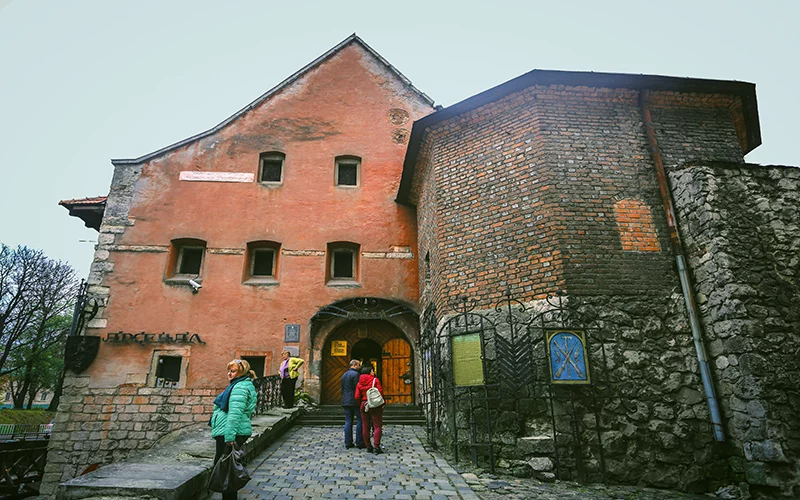
The Arsenal Building is one of the few defensive buildings that have survived from the 16th century. A new building, almost completely destroyed by fire in 1571, was rebuilt in 1575. The building, which has a harsh and gloomy appearance, was used as an unofficial prison in the 18th century.
This historical building has been serving as the Lviv Arsenal (Arms Museum) affiliated to the Lviv Historical Museum since 1991. The only museum of this type in Ukraine. Its collection impresses with its diversity and uniqueness. Bronze cannons, axes, weapons, military orders and many other items collected in 30 countries of the world are on display.
Under the museum, there is a huge space with hangar stone arches called Under Arsenal Restaurant . In one corner of the living room, there is a barbecue driven by a huge electric motor. It is served on the paper laid on the table and forks, knives and plates are not used. There are faucets and sinks on all four sides of each arch of the restaurant. You have to face a long line.
6. Armenian Quarter
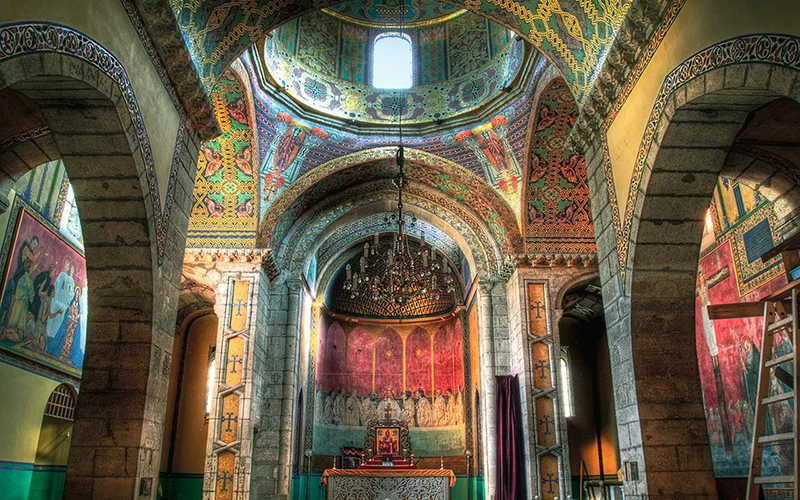
Armenian Quarter is one of the oldest quarters of the city. The original spirit of Eastern Christian culture comes to life here. In the 13th century, when it was ruled by the Mongol-Tatar invasion, it became a shelter for Armenians who left Ani in Kars, the former capital of the Armenian kingdom, and fled.
In the neighborhood located in the northern part of the city, Armenians established their churches, schools, libraries, hospitals and theaters. At that time, the city of Lviv, together with Venice and Amsterdam, was one of the three main Armenian centers of Europe. Most of the buildings date from the 16th century.
Lviv Armenian Church has an impressive interior. Some of the paintings on its walls are more than 600 years old. The dome of the temple is decorated with mosaics. The most important feature of the building, which is famous for its wall paintings, is that you can see the works of the Austrian painter Gustav Kilimt. The church, dated 1363, is still open for worship.
7. Lviv Opera House
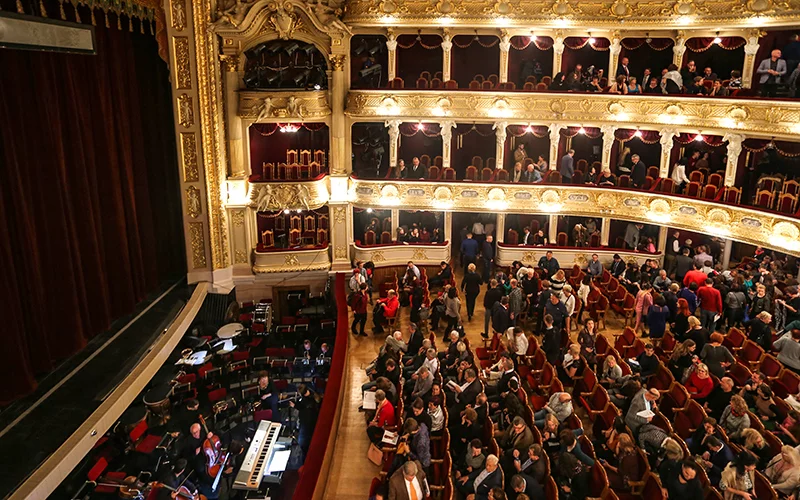
Lviv Opera House is one of the most important buildings of Lviv, located on Svobody Street. Lviv Opera House, built in 1900 in Neo-Renaissance style, is one of the most beautiful halls in Europe. The building, which is especially famous for its Aynalı Hall, is very good in terms of acoustics. The building, which is adorned with statues, is located at the end of Freedom Boulevard.
This must be the most magnificent building in Lviv, both inside and outside. Built in 1900, the building is said to be the most beautiful opera house in Europe after Paris and Milan. With its flamboyant exterior and impressive interior decoration, it is compared to the Vienna State Opera. Polish architect Zygmunt Gorgolewski is said to have attempted suicide after realizing that the underground waters of the Plotva River had damaged the foundation of the theatre.
II. The opera, where performances continued even during World War II, was closed for a short period of maintenance only in the 1930s. Every season, new performances are presented at the Opera House on Liberty Avenue (Svobody Avenue). Check to buy your ticket before coming to Lviv.
8. Taras Shevchenko Boulevard
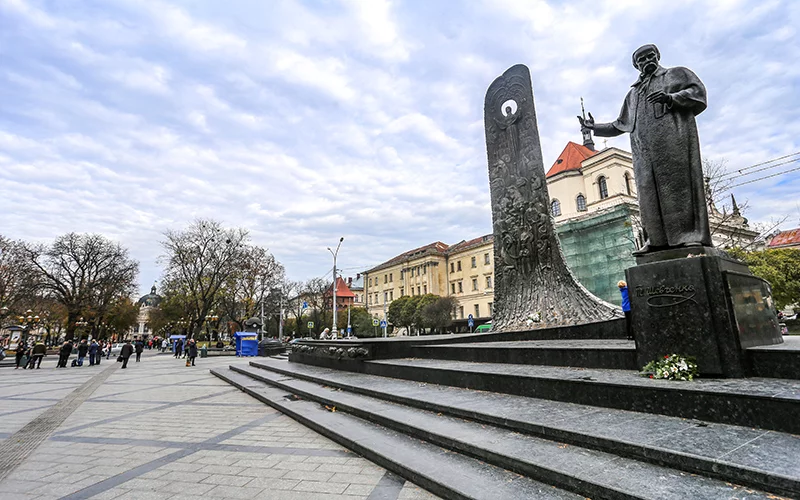
Shevchenko Square is a colorful square with all the famous shops, cafes, pubs and restaurants of Lviv. You can have something to eat or unwind with a cup of coffee in Shevchenko Square, which is considered the most luxurious area of the city.
Taras Shevchenko Boulevard is a wide boulevard that was planned and created in the late 18th century after the collapse of the defensive walls of the city's historic district. A magnificent monument to the poet, painter, folk hero Shevchenko, who led the development of Ukraine's national consciousness, is located in the middle of the boulevard.
Next to the statue, the figure of Stella rises from a height of 12 meters with its wave-like, symbolic reliefs. This is one of the favorite meeting places of the people. At the southern end of the boulevard, one of the coolest places in the city, rises the statue of the Polish poet and patriot Adam Mickiewicz, who took refuge in Istanbul for a while and whose house in Tarlabaşı is preserved as a museum.
The 21-meter-high column made of Italian granite and the 3-meter-high Mickiewicz Statue were erected with the official opening ceremony in 1904. At the northern end of the boulevard is the Lviv State Opera and Ballet.
9. Potocki Palace
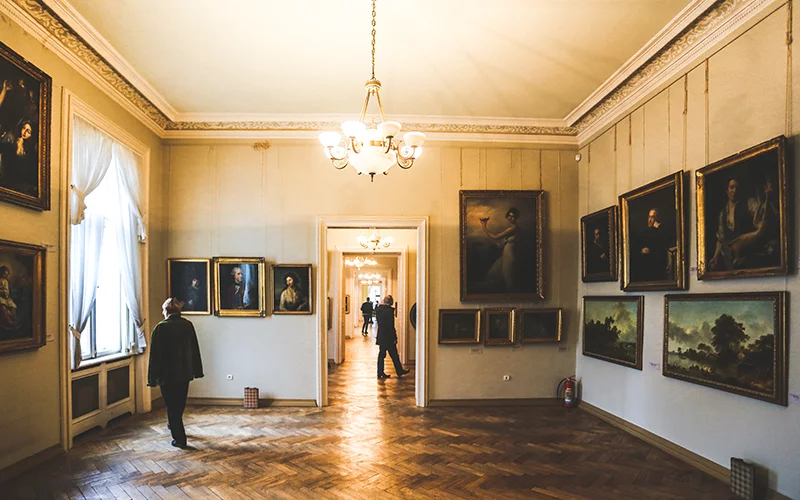
Potocki Palace is located in the city center of Lviv, in the Kopernika district. Potocki Palace, built in the 1880s as the residence of the Potockis, one of the most powerful families in Europe, was designed by the French architect Louis Dauvergne. One of the most magnificent palaces in the city, dating from the 19th century.
The decoration and furnishings of the palace have remained almost unchanged until today, as if revealing all the wealth and splendor. The place, which serves as the Lviv Picture Gallery today, is a point that can attract the attention of art lovers. It is located on Kopernyka Street, which intersects with Svobody Street, where the Lviv Opera House is located.
The elegant building, reminiscent of French Renaissance palaces, was used for wedding ceremonies in the seventies. The film adaptation of the famous work 'The Three Musketeers and d'Artagnan' by the French writer Alexander Dumas was shot here in 1978.
The palace, which has been used as the residence of the President of Ukraine since the 2000s, also hosts exhibitions from time to time. Women's World Chess Championship 2016 matches were also held in this palace. I suggest you add it to your list of places to visit in Lviv.
10. Lychakiv Cemetery
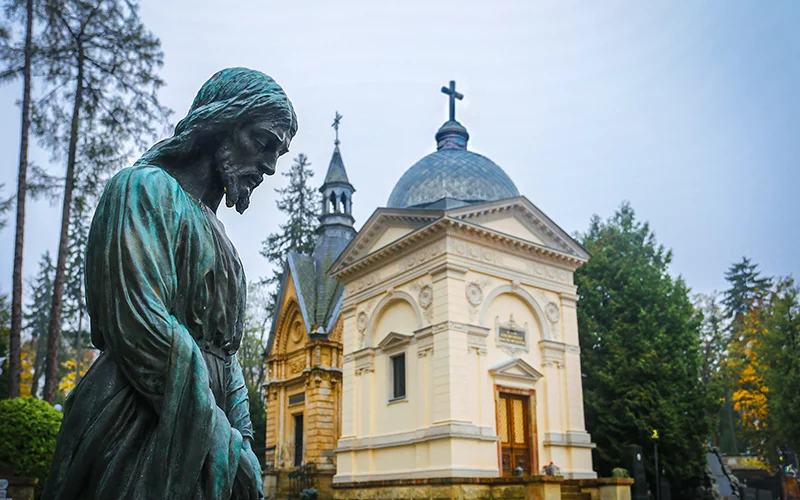
Lichakiv Cemetery is the most important cemetery in Europe as well as Ukraine. Don't go to Lviv and say you're going to visit a cemetery! Since 1787, the city's celebrities, writers, actors, intellectuals, government officials and nobles have been buried here.
There are more than 2000 tombstones in completely different architectural styles and more than 500 sculptures, each a work of art. The inscriptions on the tombstones are written in Ukrainian, Polish, German, Serbian, Italian, Armenian, Latin, Hebrew and Russian.
There is a fee for admission as it is a museum. Liçakiv can be visited with guided tours. You need to spare at least 1 hour for sightseeing. It can be reached by tram number 7. Use public transport on the way, and walk downhill to the city center on the way back.
11. Latin Cathedral
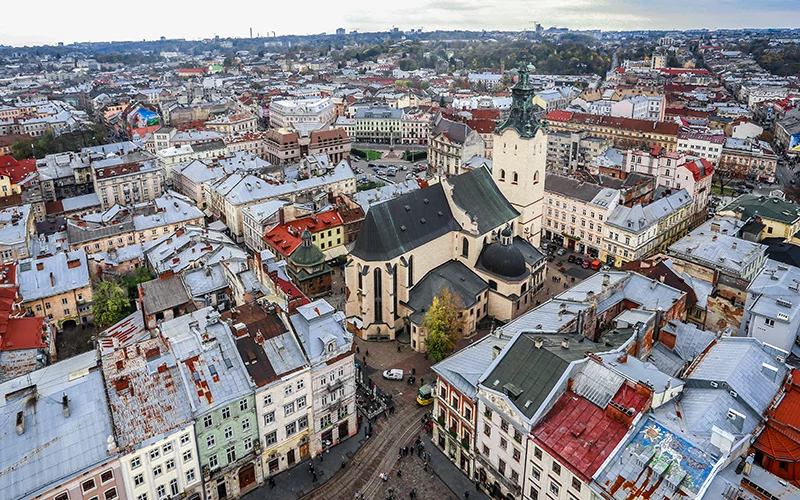
The Latin Cathedral (Basilica of the Assumption of the Blessed Virgin Mary), which is older than all other buildings in Lviv and has witnessed the historical past of the city, is the city's most magnificent structure. This building was the center of the city during the medieval period. It was built on the site of a small wooden Roman Catholic church dedicated to the Holy Trinity, built in 1344 and lost in a fire six years later.
Its construction started in 1360 and it took until 1481 to be completed. The building, which you can literally describe as gothic from the outside, has a gilded interior and baroque designs. Pope II. John Paul attended a service here in June 2001.
12. Ivan Franko Park
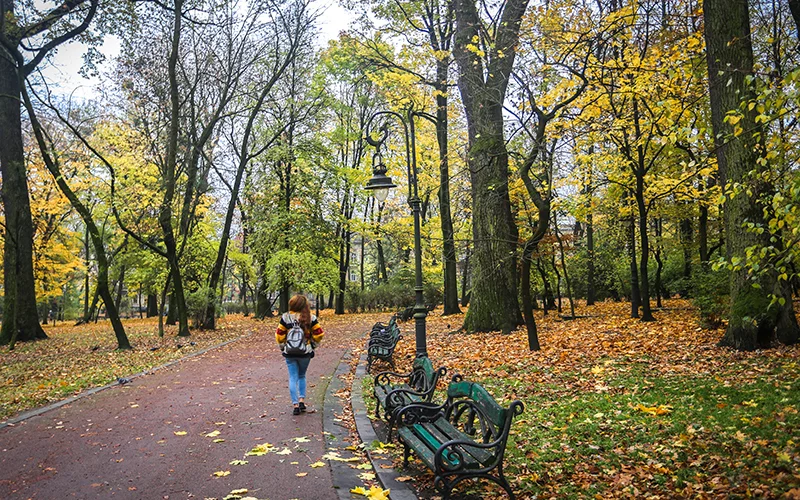
French politician Charles de Gaulle about Lviv: “I have seen parks in the city before, but this is the first time I see the city in the park.” said. Described as the 'City in Parks', Ivan Franko Park in Lviv is like a forest. There are trees in the park that are thought to be 400 years old. Especially in autumn, it takes on exquisite colors. A place where you can forget all your tiredness.
st. George's Cathedral , St. It is located on Yura Square. Close to Ivan Franko Park. Built between 1744 and 1761 in the Rococo architectural style, the cathedral is one of the most beautiful religious buildings in Europe. st. The bell in the tower of St. George's Cathedral, made in 1341, is considered the oldest church bell in Ukraine.
High Castle , a viewing platform on the ruins of an old castle rising on a hill. Climbing the hill, where a magnificent view of Lviv is observed, is quite tiring. However, you can take a breather in the park on the hill and enjoy the lush nature.
Olesko Castle is the right address for those looking for an alternative outside the city center of Lviv. The castle dating back to 1390, which gained importance as a museum complex, is one of the oldest structures in the Ukraine region. In the exhibition area in the castle, the cultural atmosphere of the past periods is revived, and the area where the wooden sculpture collection is located attracts the attention of the visitors.
In Lviv, which attracts attention in Eastern Europe with its beer, chocolate and coffee production, apart from the places to visit, the Virtuosi Music Festival is held in the spring and the Zoloty Lev festival in the autumn. In November, you can attend the opera festival Solomia Kryshelnytska.
What to eat in Lviv
In Lviv, where many restaurants are located, the dishes most consumed by Ukrainians are minced meat dough, which is a type of ravioli known as piruhi, pyrizhky loaves filled with various fillings, pancakes with vegetables or meat called nalisnyky, goulash, which you can taste in the whole Balkan region, potato dumplings called deruny, and It stands out as the Kiev-style chicken.
Apart from these, compotes called compot and uzvar accompany the main dishes, kvass, which is a kind of rye bread, and vodkas called Horilka and Samohon are also very popular. There are many good addresses in the city where you can eat or drink coffee. The First Lviv Grill Restaurant of Meat and Justice, which is especially loved by travelers, is in the first place. This is by far the most beautiful place to eat in Lviv, and it is an interestingly designed place with a medieval concept.
This is followed by Kumpel, which is known as the most luxurious restaurant in the city. Likewise, Bread and Wine, Beef Steak, Mons Pius, Baczewski Restaurant are very tasty, affordable and highly preferred places for meat dishes. As in all Ukraine, the portions are quite large and filling in Lviv.
If you wish, you can go to Glory Cafe for breakfast, try different kinds of pizza at Celentano Pizza, and stop by Bubble Waffle to try a waffle while visiting the city. You can sit in Lviv Coffee mining Manufacture or Gasova Lampa to take a breather and have a nice coffee, or if you prefer tea, you can sit in Victoria Tea House. Strudel Haus, which is famous for its strudel varieties, will make you very happy.
Lviv shopping
Lviv is a city with cute and small shops and cute boutiques instead of big shopping malls. The heart of shopping in Lviv beats in the old town of the city. Souvenirs, local clothes of the country sold on the streets of historical Lviv, handmade products, rugs, specially produced chocolates and coffee products are very popular. Besides the unique products of Ukraine, you can find different products in shopping malls, various jewelery shops and bookstores.
King's Cross Leopolis, a shopping center just outside the city center, has various shops and stores as well as restaurants. Shop Under Kumpel, which is also a shopping center with the same concept, and Magnus Shopping Center, where especially textile stores are concentrated; For those who like jewellery, Kolektsiya Jewelery Boutique and Opera Passage with expensive and luxurious shops are the prominent addresses.
For those who enjoy alternative shopping, the Shchos Tsikave Outdoor Art Gallery, which has products on wood and glass art; Gothic Hall Antique and Modern Art Shop, located in a historical atmosphere, where you can find antiques; Lviv Candles Manufactory; Pravda B Gallery and Something Interesting are different spots of the city for creative, tasteful and different handmade products.
Lviv nightlife
Lviv, which has the title of the city with the most colorful nightlife in Ukraine, together with the capital Kiev, owes this title to the tourist activity that continues throughout the year. Many of the popular nightclubs require a fee to enter. The entrance fee ranges from 50-150UAH. In order not to encounter a negative situation in the city, it is useful to stay away from addresses other than known, famous or non-corporate nightclubs.
Lviv nightlife is shaped by two separate venues, bars and nightclubs. Bars have a more economical and more intimate environment than nightclubs. The most famous bars of the city are Pyana Vishnya Bar, Libraria Speak Easy Bar, Rafinad People Club and Music Lab.
Malevich Night Club, !FESTrepublic Night Club, HiresH Night Club, The Cult Night Club, Zanzibar Night Club and Picasso Night Club are among the most famous nightclubs where you can enjoy the vibrant nightlife of the city and have fun with loud music until the first light of the next day.
Where to stay in Lviv
Depending on your budget, you have many options for accommodation in Lviv. Rental houses, hotels and hostels are very affordable compared to other European cities. The city center is the best option for accommodation in Lviv. Especially the area around Rynok Square is highly preferred due to its proximity to touristic areas.
Bank Hotel overlooking the Ivan Franko Park in Lviv was the place where I stayed for 3 nights. One of the best hotels in Lviv. The building, which served as the branch of the Austro-Hungarian Bank from 1870 to 1914, welcomes its guests as a hotel since June 2018. It takes 15 minutes to walk from the hotel to Rynok Square.
How to get to Lviv
There are direct flights from Turkey to Lviv by Turkish Airlines from Istanbul Airport, and by Pegasus Airlines from Sabiha Gökçen Airport. The flight time from Istanbul to Lviv is 2 hours. Ukraine Airlines connecting Kiev to Lviv flights can be preferred for a more economical journey. Located in Lviv, the airport is known by the name of the Galician King Danylo Halytskyi.
Lviv Airport is 6 km from the city center. You can easily go to the city center with the Aero Express taxis, the official taxi operator of Lviv Airport. Buses No. 48, which are a more economical option than taxis, operate every day of the week between 07.00 in the morning and 22.00 in the evening. The city center can be reached in 20 minutes by bus.
The trolleybus is the most affordable public transportation vehicle in the city. You can be at the center in about 10-15 minutes by taking the trolleybus from the old terminal building at the airport. Trolleybuses operate every day of the week between 06:00 in the morning and 22:00 in the evening.
Lviv is the most vibrant city in Ukraine, famous for its historical textures, museums and festivals. It combines many fun options and unforgettable scenery with beautiful architecture. Lviv, one of the beautiful cities of Central Europe , is a route that can be visited in all four seasons.
